Abstract
The immunosuppression that develops during Chagas' disease and African sleeping sickness is thought to facilitate survival of the causative agents in their mammalian hosts. Whereas a number of manifestations of immunosuppression manifested during the course of these diseases has been reported in patients and animals, the mechanisms by which they are induced remain obscure. An in vitro system in which phytohaemagglutinin (PHA)-stimulated human peripheral blood mononuclear (PBMC) were co-cultured with purified Trypanosoma cruzi or T. brucei rhodesiense was used in the present work to establish whether these organisms were able to alter the capacity of activated helper/inducer (CD4+) or cytotoxic/suppressor (CD8+) cells to express T-cell receptor (TcR). Suppressed interleukin-2 receptor (IL-2R), known to be caused by both the trypanosomes and supernatants containing their secretion products, was the independent parameter used to demonstrate the occurrence of immunosuppression in all experiments. We found marked reductions in the percentage of TcR+ cells in T. cruzi-containing cultures as early as 18 hr after PHA stimulation. This alteration was still readily demonstrable after 72 hr of culture, i.e. when last tested for. Suppressed TcR expression occurred concomitantly with reduced levels of CD4 or CD8 molecules on the surface of helper/inducer and cytotoxic/suppressor T lymphocytes, respectively, indicating that the parasite had induced more than one alteration in the same cells. These effects were reproduced when the trypanosomes were separated from the PBMC by a 0.45 micron pore size filter or when filtrates from T. cruzi suspensions substituted for the parasite in the cultures, indicating that TcR suppression was mediated by a parasite secretion product(s). Interestingly, neither T. b. rhodesiense nor filtrates of suspensions of this organism altered significantly the level of TcR expression in cultures in which suppressed IL-2R expression by activated human T cells took place. Thus despite sharing the ability to impair IL-2R expression, T. cruzi and T.b. rhodesiense appear to differ in other mechanisms by which they affect human T-cell function. If occurring in infected hosts, the alterations that T. cruzi causes in the expression of TcR, CD4, CD8 and IL-2R--all molecules playing important roles in lymphocyte activation--could contribute to the development of the immunosuppression observed during the acute phase of Chagas' disease.
Full text
PDF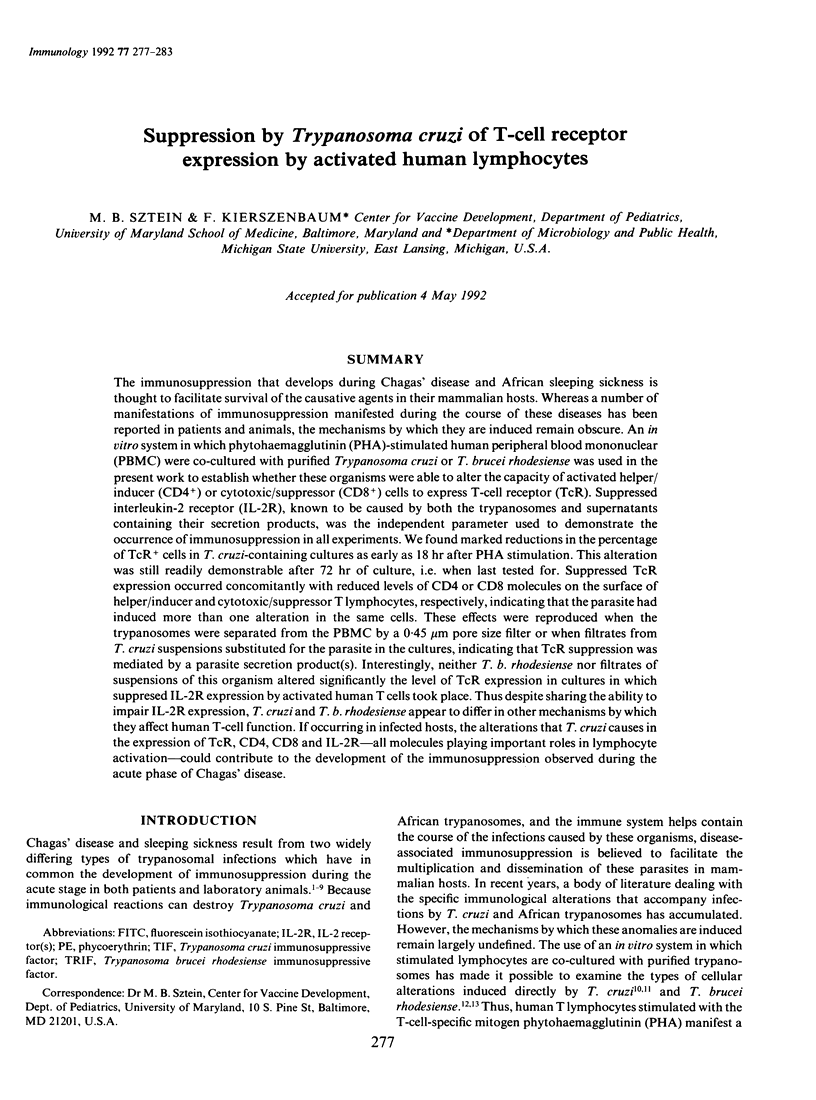
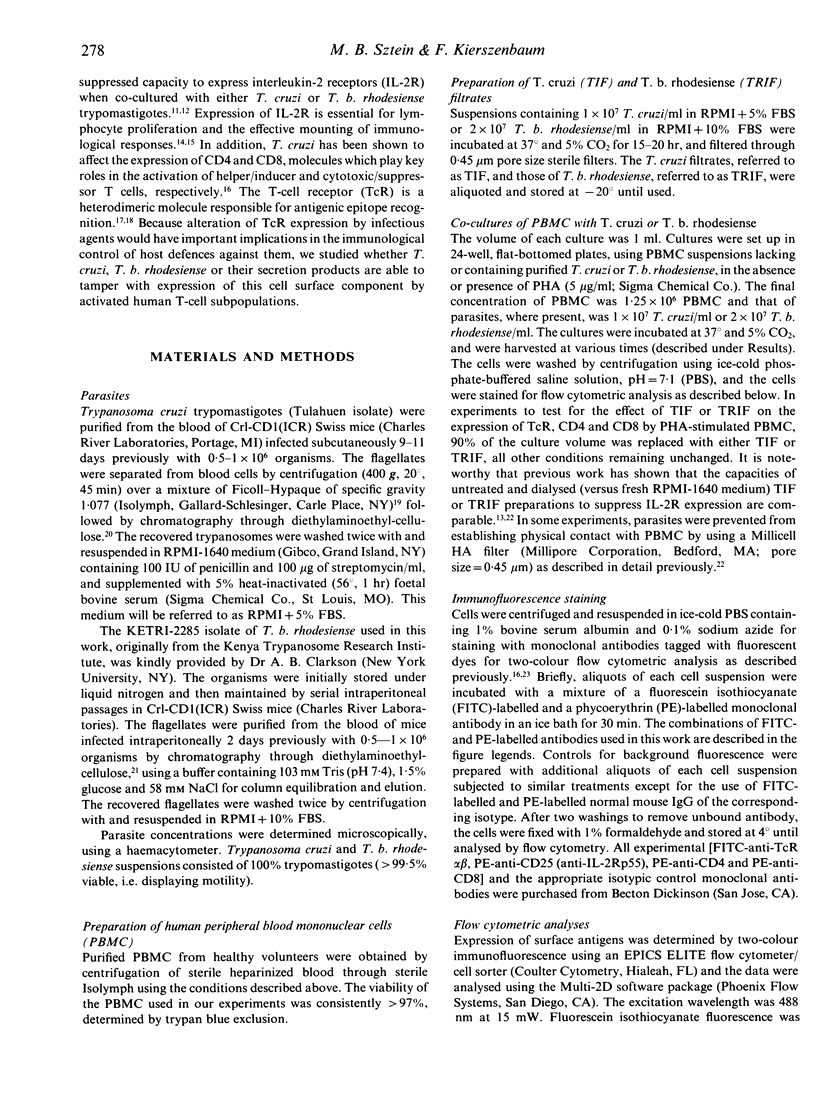
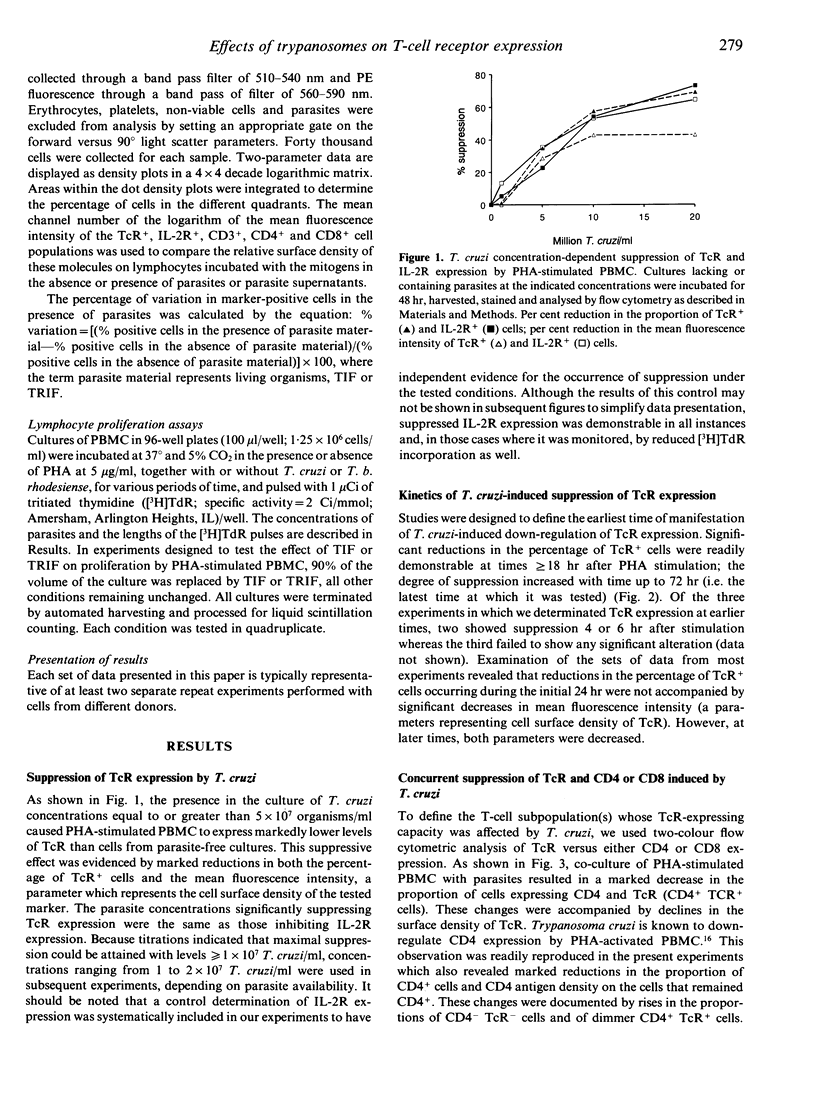
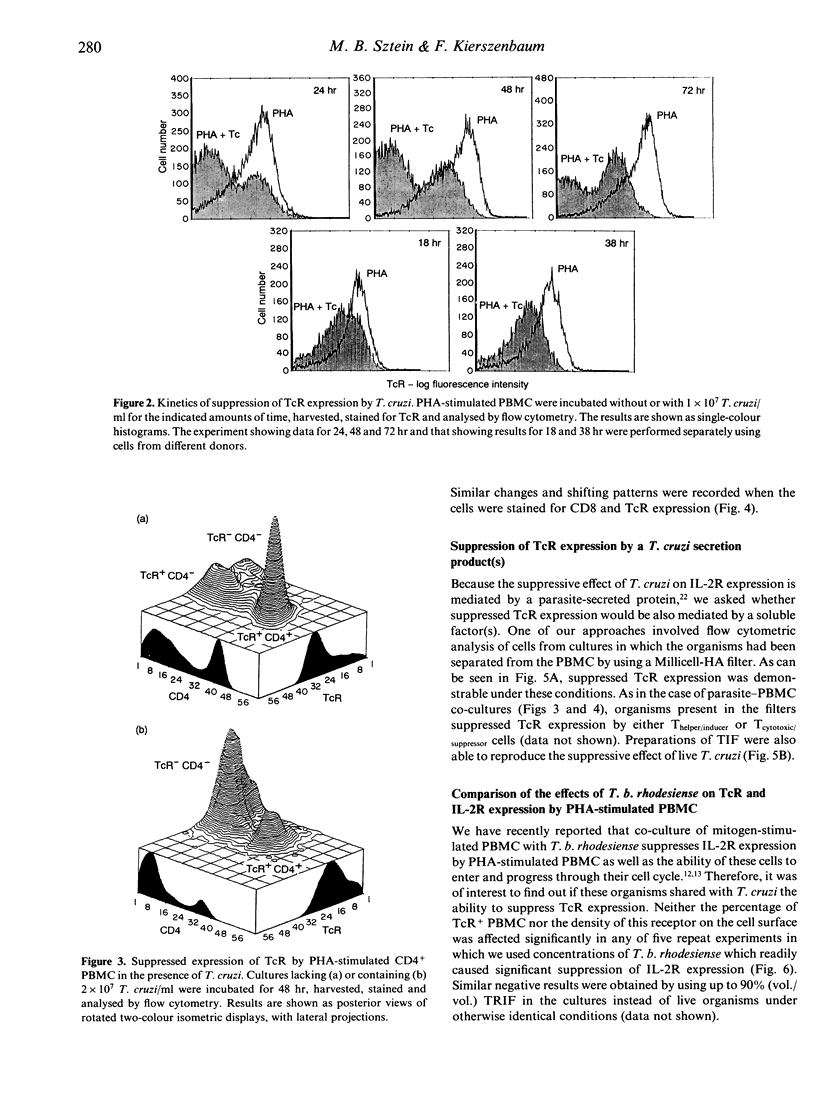
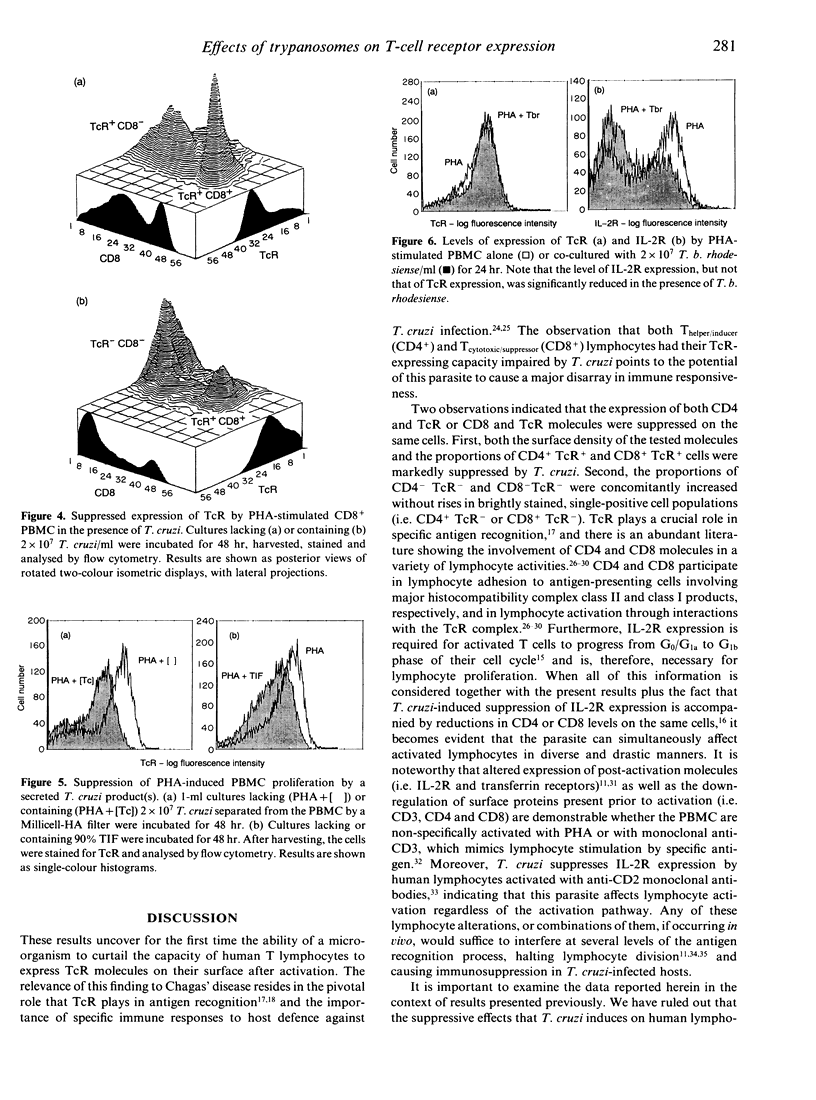
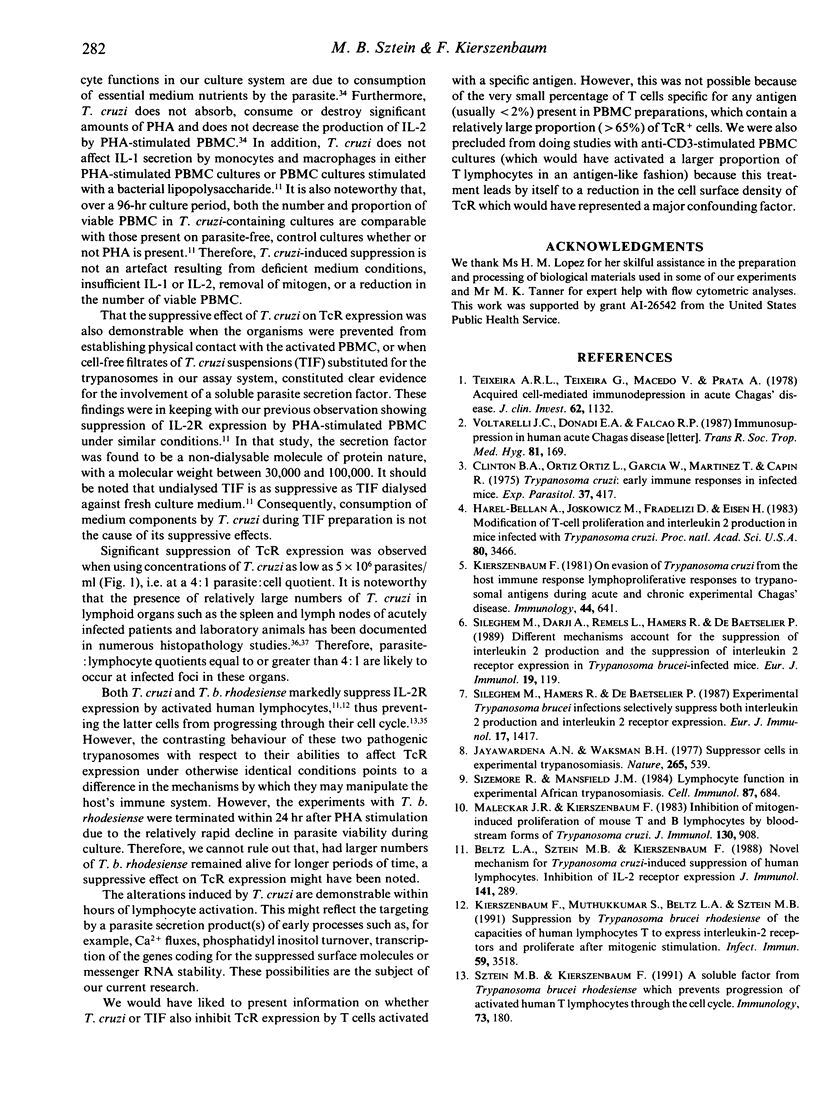
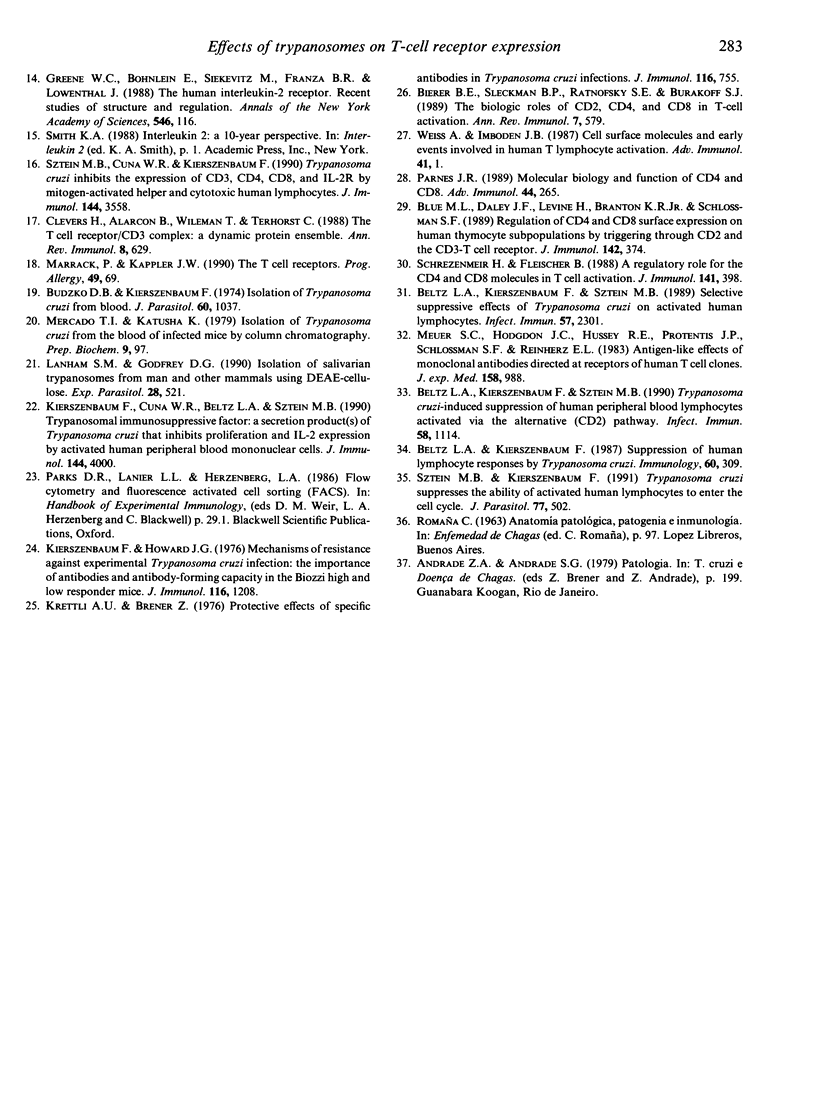
Selected References
These references are in PubMed. This may not be the complete list of references from this article.
- Beltz L. A., Kierszenbaum F. Suppression of human lymphocyte responses by Trypanosoma cruzi. Immunology. 1987 Feb;60(2):309–315. [PMC free article] [PubMed] [Google Scholar]
- Beltz L. A., Kierszenbaum F., Sztein M. B. Selective suppressive effects of Trypanosoma cruzi on activated human lymphocytes. Infect Immun. 1989 Aug;57(8):2301–2305. doi: 10.1128/iai.57.8.2301-2305.1989. [DOI] [PMC free article] [PubMed] [Google Scholar]
- Beltz L. A., Kierszenbaum F., Sztein M. B. Trypanosoma cruzi-induced suppression of human peripheral blood lymphocytes activated via the alternative (CD2) pathway. Infect Immun. 1990 Apr;58(4):1114–1116. doi: 10.1128/iai.58.4.1114-1116.1990. [DOI] [PMC free article] [PubMed] [Google Scholar]
- Beltz L. A., Sztein M. B., Kierszenbaum F. Novel mechanism for Trypanosoma cruzi-induced suppression of human lymphocytes. Inhibition of IL-2 receptor expression. J Immunol. 1988 Jul 1;141(1):289–294. [PubMed] [Google Scholar]
- Bierer B. E., Sleckman B. P., Ratnofsky S. E., Burakoff S. J. The biologic roles of CD2, CD4, and CD8 in T-cell activation. Annu Rev Immunol. 1989;7:579–599. doi: 10.1146/annurev.iy.07.040189.003051. [DOI] [PubMed] [Google Scholar]
- Blue M. L., Daley J. F., Levine H., Branton K. R., Jr, Schlossman S. F. Regulation of CD4 and CD8 surface expression on human thymocyte subpopulations by triggering through CD2 and the CD3-T cell receptor. J Immunol. 1989 Jan 15;142(2):374–380. [PubMed] [Google Scholar]
- Budzko D. B., Kierszenbaum F. Isolation of Trypanosoma cruzi from blood. J Parasitol. 1974 Dec;60(6):1037–1038. [PubMed] [Google Scholar]
- Clevers H., Alarcon B., Wileman T., Terhorst C. The T cell receptor/CD3 complex: a dynamic protein ensemble. Annu Rev Immunol. 1988;6:629–662. doi: 10.1146/annurev.iy.06.040188.003213. [DOI] [PubMed] [Google Scholar]
- Clinton B. A., Ortiz-Ortiz L., Garcia W., Martinez T., Capin R. Trypanosoma cruzi: early immune responses in infected mice. Exp Parasitol. 1975 Jun;37(3):417–425. doi: 10.1016/0014-4894(75)90012-0. [DOI] [PubMed] [Google Scholar]
- Greene W. C., Böhnlein E., Siekevitz M., Franza B. R., Lowenthal J. The human interleukin-2 receptor. Recent studies of structure and regulation. Ann N Y Acad Sci. 1988;546:116–121. doi: 10.1111/j.1749-6632.1988.tb21626.x. [DOI] [PubMed] [Google Scholar]
- Harel-Bellan A., Joskowicz M., Fradelizi D., Eisen H. Modification of T-cell proliferation and interleukin 2 production in mice infected with Trypanosoma cruzi. Proc Natl Acad Sci U S A. 1983 Jun;80(11):3466–3469. doi: 10.1073/pnas.80.11.3466. [DOI] [PMC free article] [PubMed] [Google Scholar]
- Jayawardena A. N., Waksman B. H. Suppressor cells in experimentally trypanosomiasis. Nature. 1977 Feb 10;265(5594):539–541. doi: 10.1038/265539a0. [DOI] [PubMed] [Google Scholar]
- Kierszenbaum F., Cuna W. R., Beltz L. A., Sztein M. B. Trypanosomal immunosuppressive factor: a secretion product(s) of Trypanosoma cruzi that inhibits proliferation and IL-2 receptor expression by activated human peripheral blood mononuclear cells. J Immunol. 1990 May 15;144(10):4000–4004. [PubMed] [Google Scholar]
- Kierszenbaum F., Howard J. G. Mechanisms of resistance against experimental Trypanosoma cruzi infection: the importance of antibodies and antibody-forming capacity in the Biozzi high and low responder mice. J Immunol. 1976 May;116(5):1208–1211. [PubMed] [Google Scholar]
- Kierszenbaum F., Muthukkumar S., Beltz L. A., Sztein M. B. Suppression by Trypanosoma brucei rhodesiense of the capacities of human T lymphocytes to express interleukin-2 receptors and proliferate after mitogenic stimulation. Infect Immun. 1991 Oct;59(10):3518–3522. doi: 10.1128/iai.59.10.3518-3522.1991. [DOI] [PMC free article] [PubMed] [Google Scholar]
- Kierszenbaum F. On evasion of Trypanosoma cruzi from the host immune response. Lymphoproliferative responses to trypanosomal antigens during acute and chronic experimental Chagas' disease. Immunology. 1981 Nov;44(3):641–648. [PMC free article] [PubMed] [Google Scholar]
- Krettli A. U., Brener Z. Protective effects of specific antibodies in Trypanosoma cruzi infections. J Immunol. 1976 Mar;116(3):755–760. [PubMed] [Google Scholar]
- Lanham S. M., Godfrey D. G. Isolation of salivarian trypanosomes from man and other mammals using DEAE-cellulose. Exp Parasitol. 1970 Dec;28(3):521–534. doi: 10.1016/0014-4894(70)90120-7. [DOI] [PubMed] [Google Scholar]
- Maleckar J. R., Kierszenbaum F. Inhibition of mitogen-induced proliferation of mouse T and B lymphocytes by bloodstream forms of Trypanosoma cruzi. J Immunol. 1983 Feb;130(2):908–911. [PubMed] [Google Scholar]
- Marrack P., Kappler J. W. The T cell receptors. Chem Immunol. 1990;49:69–81. [PubMed] [Google Scholar]
- Mercado T. I., Katusha K. Isolation of Trypanosoma cruzi from the blood of infected mice by column chromatography. Prep Biochem. 1979;9(1):97–106. doi: 10.1080/00327487908061675. [DOI] [PubMed] [Google Scholar]
- Meuer S. C., Hodgdon J. C., Hussey R. E., Protentis J. P., Schlossman S. F., Reinherz E. L. Antigen-like effects of monoclonal antibodies directed at receptors on human T cell clones. J Exp Med. 1983 Sep 1;158(3):988–993. doi: 10.1084/jem.158.3.988. [DOI] [PMC free article] [PubMed] [Google Scholar]
- Parnes J. R. Molecular biology and function of CD4 and CD8. Adv Immunol. 1989;44:265–311. doi: 10.1016/s0065-2776(08)60644-6. [DOI] [PubMed] [Google Scholar]
- Schrezenmeier H., Fleischer B. A regulatory role for the CD4 and CD8 molecules in T cell activation. J Immunol. 1988 Jul 15;141(2):398–403. [PubMed] [Google Scholar]
- Sileghem M., Darji A., Remels L., Hamers R., De Baetselier P. Different mechanisms account for the suppression of interleukin 2 production and the suppression of interleukin 2 receptor expression in Trypanosoma brucei-infected mice. Eur J Immunol. 1989 Jan;19(1):119–124. doi: 10.1002/eji.1830190119. [DOI] [PubMed] [Google Scholar]
- Sileghem M., Hamers R., De Baetselier P. Experimental Trypanosoma brucei infections selectively suppress both interleukin 2 production and interleukin 2 receptor expression. Eur J Immunol. 1987 Oct;17(10):1417–1421. doi: 10.1002/eji.1830171005. [DOI] [PubMed] [Google Scholar]
- Sizemore R. C., Mansfield J. M. Lymphocyte function in experimental African trypanosomiasis. VII. Loss of antigen-nonspecific suppressor-T-cell activity. Cell Immunol. 1984 Sep;87(2):684–691. doi: 10.1016/0008-8749(84)90036-4. [DOI] [PubMed] [Google Scholar]
- Sztein M. B., Cuna W. R., Kierszenbaum F. Trypanosoma cruzi inhibits the expression of CD3, CD4, CD8, and IL-2R by mitogen-activated helper and cytotoxic human lymphocytes. J Immunol. 1990 May 1;144(9):3558–3562. [PubMed] [Google Scholar]
- Sztein M. B., Kierszenbaum F. A soluble factor from Trypanosoma brucei rhodesiense that prevents progression of activated human T lymphocytes through the cell cycle. Immunology. 1991 Jun;73(2):180–185. [PMC free article] [PubMed] [Google Scholar]
- Sztein M. B., Kierszenbaum F. Trypanosoma cruzi suppresses the ability of activated human lymphocytes to enter the cell cycle. J Parasitol. 1991 Jun;77(3):502–505. [PubMed] [Google Scholar]
- Teixeira A. R., Teixeira G., Macêdo V., Prata A. Acquired cell-mediated immunodepression in acute Chagas' disease. J Clin Invest. 1978 Dec;62(6):1132–1141. doi: 10.1172/JCI109232. [DOI] [PMC free article] [PubMed] [Google Scholar]
- Voltarelli J. C., Donadi E. A., Falcao R. P. Immunosuppression in human acute Chagas disease. Trans R Soc Trop Med Hyg. 1987;81(1):169–170. doi: 10.1016/0035-9203(87)90324-5. [DOI] [PubMed] [Google Scholar]
- Weiss A., Imboden J. B. Cell surface molecules and early events involved in human T lymphocyte activation. Adv Immunol. 1987;41:1–38. doi: 10.1016/s0065-2776(08)60029-2. [DOI] [PubMed] [Google Scholar]


